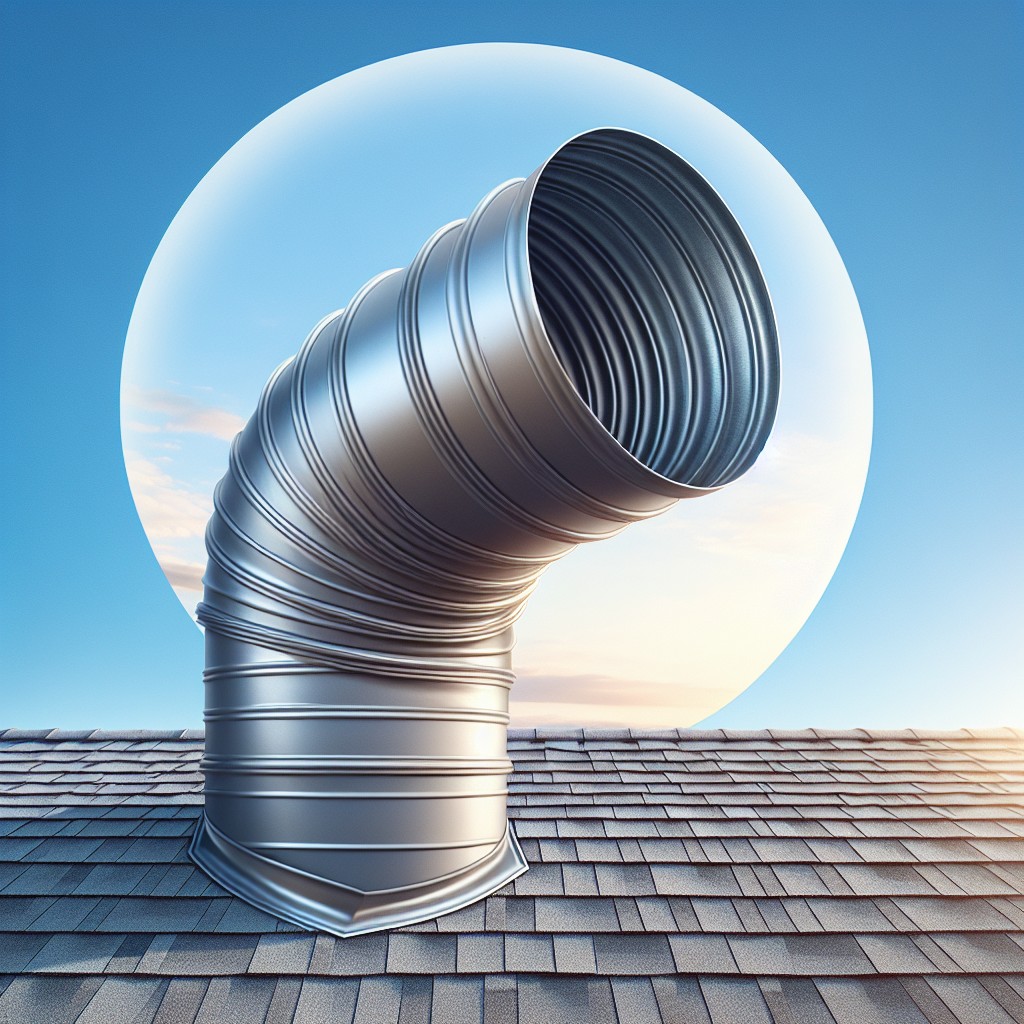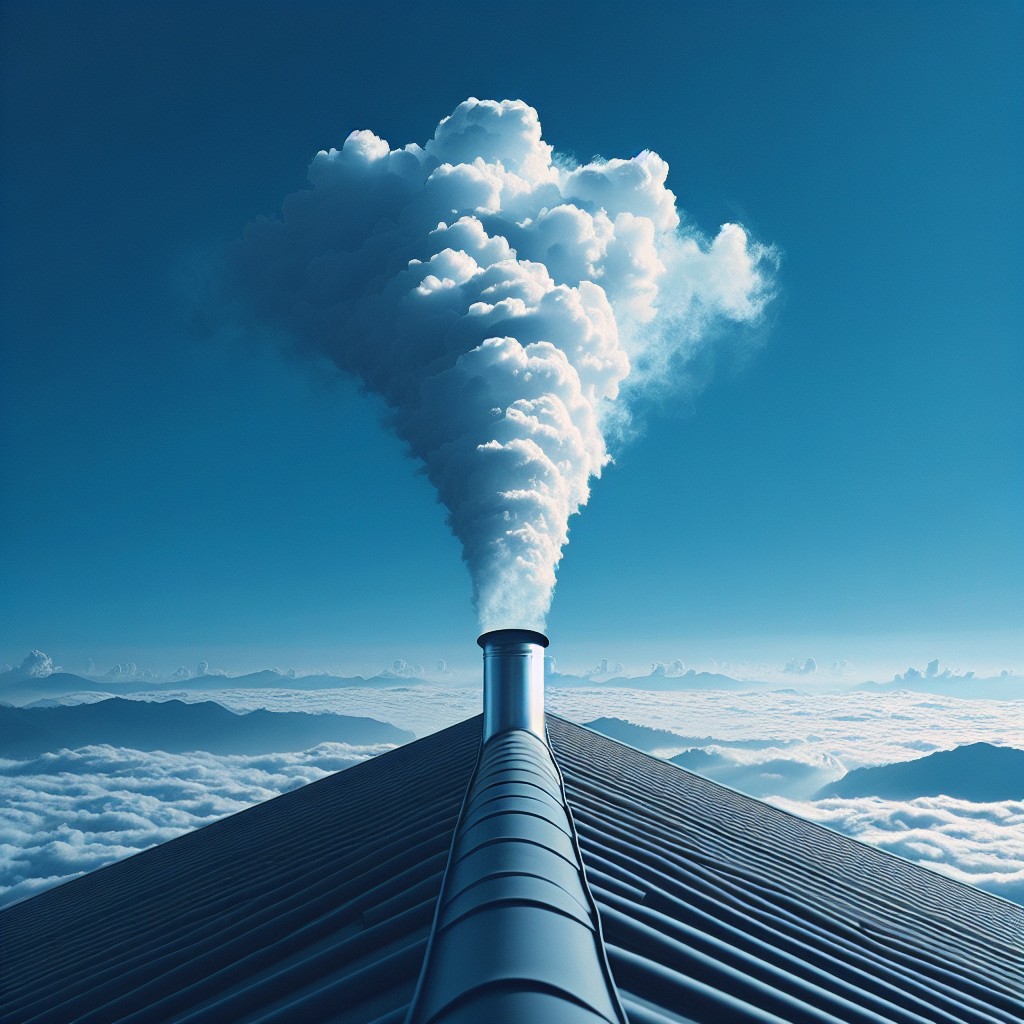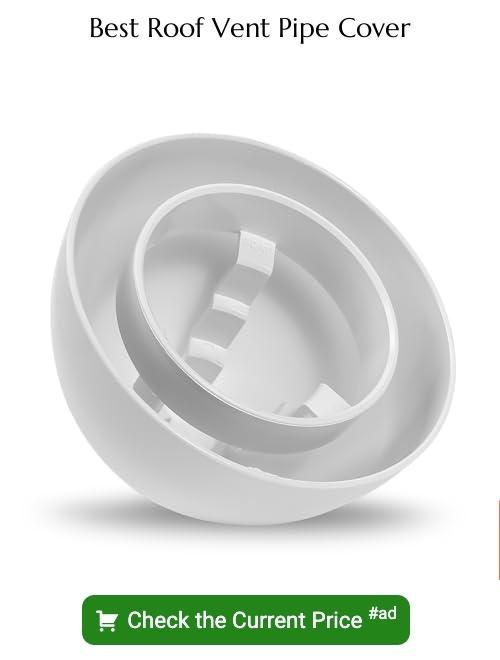Last updated on
Prolong the lifespan of your roof and maintain a healthy home environment by understanding and maintaining your roof vent pipe because it plays a pivotal role in your home’s ventilation system.
Key takeaways:
- Vent pipes regulate air pressure in the plumbing system.
- They safely vent sewer gases out of the building.
- Vent pipes facilitate proper drainage and prevent siphoning.
- Regular inspections and maintenance prevent blockages and leaks.
- Vent pipe caps protect against debris, pests, and water intrusion.
What Are Plumbing Roof Vents?

Plumbing roof vents, also known as vent stacks or soil stacks, are critical components of a residential or commercial building’s plumbing system. These pipes extend from the plumbing fixtures in the property to the outside, usually protruding through the roof. They serve several key functions:
- Airflow regulation: By allowing air into the plumbing system, vent pipes help maintain proper atmospheric pressure. This regulated pressure permits wastewater and sewage to flow smoothly to the sewer or septic system without air vacuums or pressure disruptions that could impede the flow.
- Odor dispersion: These vents safely channel odors and gases produced by waste and sewage up and out of the building, ensuring that they don’t back up into living spaces, which contributes to the overall indoor air quality.
- Preventing traps from siphoning: Each plumbing fixture contains a trap, which holds water to prevent sewer gases from entering the home. Vent pipes help maintain the water seal in these traps by preventing siphoning, which could otherwise allow gases to seep back into the house.
Typically constructed from PVC, ABS, copper, or cast iron, plumbing roof vents must adhere to strict building codes to ensure they function correctly, safely releasing gases and balancing the pressure in your plumbing system.
Functions of a Roof Vent Pipe

Roof vent pipes serve several critical functions in maintaining a home’s plumbing system:
1. Regulating air pressure: They prevent the siphoning of water from traps by allowing fresh air into the plumbing system to maintain neutral air pressure.
2. Venting sewer gases: By safely directing harmful gases upward and out of the plumbing system, these vents ensure that these gases do not accumulate inside the home.
3. Facilitating proper drainage: A consistent flow of air allows wastewater and solid materials to flow smoothly through drain pipes without creating negative pressure or vacuum effects.
4. Allowing for wastewater system maintenance: These pipes provide direct access to the sewer system for inspections, cleanings, and other maintenance tasks.
By fulfilling these roles, vent pipes ensure the plumbing system functions efficiently and hygienically.
Common Problems With Vent Pipes On Roof
Vent pipes protruding from your roof serve the crucial role of allowing gases from your plumbing system to escape, which in turn enables water to flow smoothly through the pipes. Despite their importance, these fixtures are prone to a number of issues that can disrupt their function:
Blockages: Leaves, debris, and even dead animals can obstruct the airflow in vent pipes, leading to poor drainage and sewer gas smells inside the home.
Cracks and Leaks: Weathering and age can cause vent pipes to crack, which might allow water into the home and cause damage to the interior.
Condensation: In colder climates, moisture inside the vent pipes can freeze, forming ice that blocks the vent and causes drainage problems.
Improper Installation: Vent pipes that are improperly installed may not provide adequate ventilation, leading to slow drains and a buildup of sewer gas.
Worn Sealants: Around the vent pipe base, sealants can deteriorate over time, creating pathways for water to seep into the structure.
Regular inspection of vent pipes can prevent these issues from escalating into more serious problems. It’s imperative to keep an eye on these rooftop components to ensure your plumbing system functions optimally.
Recognizing a Clogged Vent Pipe
Identifying a blockage within your plumbing system often starts with noticing signs typically associated with a clogged vent pipe. These include:
- Slow Draining: When water takes longer than usual to drain from sinks, bathtubs, or showers, a blocked vent pipe may be disrupting the proper airflow required for swift drainage.
- Gurgling Sounds: Unusual noises coming from drains could indicate trapped air attempting to escape through the water, pointing toward a vent obstruction.
- Sewage Smells: An unmistakable sign is the presence of sewer gas odors in your home. A properly functioning vent should channel these gases out through the roof, but a clog can force them back through your drains.
- Unusual Plumbing System Behavior: If toilets and drains behave unpredictably when using other fixtures, such as fluctuating water levels in toilets when running a sink, a clogged vent may be the culprit.
Prompt attention to these symptoms can prevent more complex issues and ensure that your home’s plumbing system operates efficiently. Regular inspection and maintenance are key to avoiding the inconvenience of a blocked roof vent pipe.
How to Clean and Maintain Roof Vent Pipes
Regular cleaning and maintenance of your roof vent pipes are crucial to ensuring proper ventilation and preventing blockages that can lead to severe plumbing issues.
1. Inspection: Biannually, inspect the vent pipe for signs of damage, blockage, or wear. Look for nests, leaves, or other debris that could obstruct airflow.
2. Safety First: Before climbing onto the roof, ensure you have a sturdy ladder and follow safety protocols. Consider using a safety harness and have someone spot you.
3. Clearing Debris: Using a plumber’s snake or a specialized vent pipe brush, gently remove any obstructions within the pipe. Work the tool in a circular motion to dislodge debris without damaging the pipe lining.
4. Flushing the System: After mechanical cleaning, flush the vent with a garden hose to clear remaining residue. The water pressure can help remove smaller particles.
5. Checking for Leaks: Once the vent is clear, inspect it for cracks or leaks. Water damage around the vent on your roof can indicate a problem that needs immediate attention.
6. Protecting the Pipe: Install a vent pipe cap if not already present. This simple device can prevent animals and debris from entering the vent while allowing gases to escape.
By adhering to these steps, your roof vent pipes will remain functional, contributing to the longevity of your plumbing system and the overall health of your home.
Solutions for a Leaky Roof Vent Pipe
Addressing a leaky vent pipe promptly is crucial to prevent water damage within your home. First, determine the source of the leak. Often, leaks result from a broken seal where the vent pipe exits the roof. Over time, the flashing or rubber boot that seals this junction can degrade due to weather exposure.
To remedy this, you can apply a high-quality roofing sealant around the base of the vent. This creates a waterproof barrier, preventing water from seeping into the roof’s structure. For a more durable solution, consider replacing the old flashing or boot. New installation typically involves lifting surrounding roofing materials and sliding a new flashing or boot over the pipe. Once securely in place, ensure it’s sealed and shingles are returned to their original position.
Another common issue is damage to the vent pipe itself. If the pipe has sustained cracks or holes, patching it with roofing cement or metal flashing tape might offer a temporary fix. However, if the pipe is significantly corroded or damaged, replacing the entire vent pipe is advisable for a long-lasting repair.
Regular roof inspections can catch leaks early, mitigating the need for extensive repairs. It’s essential to maintain the integrity of your roof by promptly addressing any discrepancies. If you’re uncomfortable working on the roof or the damage seems extensive, contact a professional roofer to ensure the repairs are conducted safely and effectively.
Consequences of Uncovered Roof Vent Pipes
Leaving roof vent pipes uncovered can lead to a range of issues that affect both the functionality of the plumbing system and the interior comfort of your home. Without proper covering:
1. Debris Accumulation: Leaves, twigs, and other debris can enter the vent, causing blockages that disrupt wastewater drainage and potentially lead to sewage backups.
2. Pest Entry: Birds, squirrels, and insects might find an uncovered vent pipe an ideal passage or nesting spot, which can cause obstructions and sanitation concerns.
3. Water Intrusion: Rainwater or melting snow may enter the vent, possibly leading to water damage inside walls or ceilings and contributing to mold growth.
4. Cold Air Penetration: In colder climates, exposure to open air can lead to freezing inside the pipe, which impedes proper venting and risks pipe damage from expansion.
Installing a vent pipe cover or cap is a simple and effective solution to protect your home from these adverse effects.
Step-by-Step Guide to Clean a Roof Vent Pipe
Cleaning a roof vent pipe is a straightforward task that can prevent many plumbing issues. Follow these steps for efficient cleaning:
1. Safety First: Always use a sturdy ladder to reach your roof and wear non-slip shoes. Work with a partner for extra safety.
2. Locate the Vent Pipes: Identify the pipes protruding from the roof, which are typically 2 to 4 inches in diameter.
3. Remove Debris: Check for leaves, nests, and other debris blocking the vent. Remove these carefully with a gloved hand or appropriate tool.
4. Check for Ice or Snow: In colder climates, ice or snow can seal a vent pipe. Clear it meticulously, avoiding any damage to the pipe.
5. Use a Plumber’s Snake: For deeper clogs, carefully insert a plumber’s snake into the vent pipe. Move it up and down to break up the blockage.
6. Flush with Water: After dislodging debris, flush the vent with a hose to ensure it’s clear. Water should flow freely down the pipe.
Remember, regular inspection and cleaning of your roof vent pipes can prevent more severe complications down the road. If you’re uncomfortable performing this task or encounter issues that you can’t resolve, it’s best to seek professional assistance.
When to Call a Professional for Roof Vent Issues
In certain scenarios, consulting a roofing specialist is essential for maintaining the integrity of both your vent pipe and your roof. Reach out to a professional when you notice persistent foul odors inside your home which could indicate a severely clogged vent. Additionally, if you’re experiencing consistent drainage problems despite attempts at clearing the vent or if there are signs of water damage around the vent pipe’s interior ceilings or walls, it’s time to call an expert. A professional is also warranted for safe repairs when a vent is inaccessible due to its location or if the pipe is damaged, which might require roof alterations or specialized equipment to fix. Lastly, if you are not comfortable working on the roof due to safety concerns or lack of appropriate tools, it’s always best to leave the job to those with the necessary experience and safety gear.
The Importance of Roof Vent Pipe Caps
Vent pipe caps serve crucial roles in maintaining the health and functionality of your plumbing system. They prevent debris, leaves, and small animals from entering the vent pipes, which could lead to obstructions and potential backups in the system. Moreover, these caps deter water from seeping into the vent pipes during heavy rain, reducing the risk of water damage inside your home.
Proper airflow is imperative for the efficient operation of your wastewater system; vent pipe caps ensure that air circulates smoothly, aiding in the release of sewer gases safely above the roofline. This circulation also equalizes pressure within the pipes, allowing waste to flow without resistance to the sewer or septic system. Without these caps, the system could become pressurized or vacuum-locked, hindering drainage and possibly leading to hazardous sewer gas buildup inside the home.
In areas prone to high winds or driving rain, a secure roof vent pipe cap is especially vital to prevent water from being blown into the vent stack. Similarly, in cold climates, they minimize the accumulation of snow and ice, which could block the vent, compromising the system during freezing temperatures.
Choosing the right cap for your vent pipe is key—material and design should withstand local weather conditions and complement the roof’s aesthetic, while providing the necessary protection and ventilation. Regular inspection of these caps is recommended to ensure their integrity and functionality, as damaged or missing caps need prompt replacement to prevent more significant issues.
FAQ
What happens if vent pipe is clogged?
A clogged vent pipe can result in slowed drainage, causing water to stand longer than it should and often produces unusual gurgling noises from plumbing fixtures, particularly following the flushing of the toilet or draining of the sink.
Should roof vent pipe be covered?
Yes, roof vent pipes should be appropriately covered to shield them from external elements, animals, and debris, while ensuring professional installation and maintenance for an efficient plumbing system.
What is the vent pipe sticking out of my roof?
The vent pipe protruding from your roof is most likely a plumbing vent, which is designed to regulate air pressure in the plumbing system and vent sewer gases out into the atmosphere.
How often should a roof vent pipe be inspected for blockages?
A roof vent pipe should be inspected for blockages at least once a year.
What are the common issues associated with a leaking roof vent pipe?
Common issues associated with a leaking roof vent pipe include water damage, mold growth, compromised structural integrity of the ceiling, and potential fire hazard due to contact with electrical wiring.
How are vent pipe sizes determined for proper roof ventilation?
Vent pipe sizes for proper roof ventilation are determined based on the scale and design of the house, specifically square footage of the attic space and the pitch of the roof.





